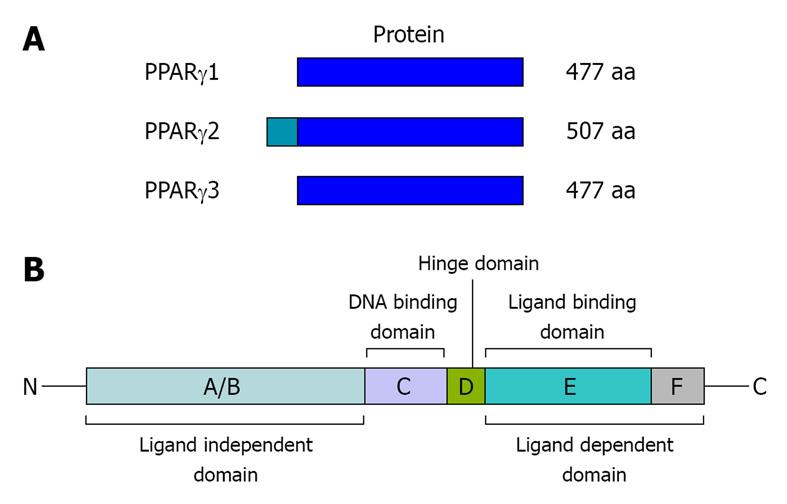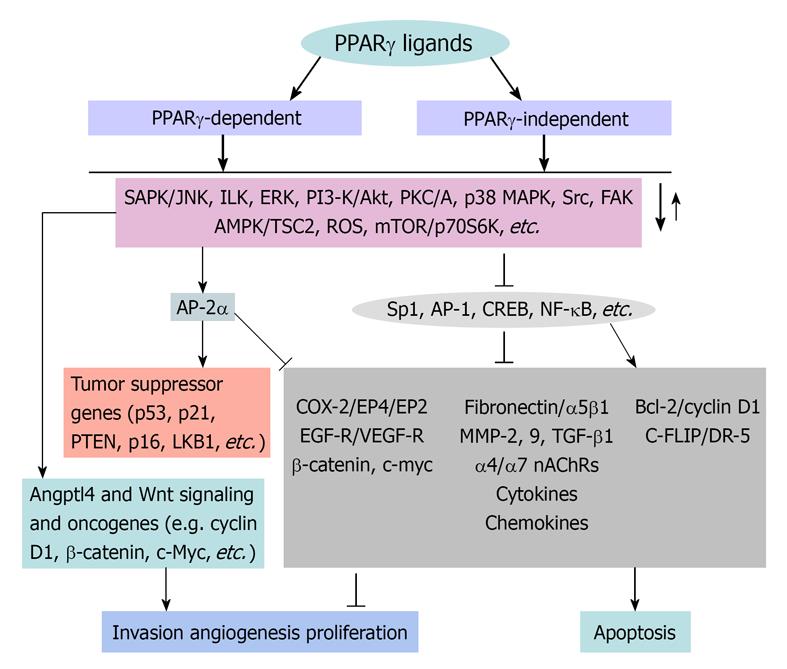Copyright
©2010 Baishideng Publishing Group Co.
World J Biol Chem. Mar 26, 2010; 1(3): 31-40
Published online Mar 26, 2010. doi: 10.4331/wjbc.v1.i3.31
Published online Mar 26, 2010. doi: 10.4331/wjbc.v1.i3.31
Figure 1 Structure of human peroxisome proliferator-activated receptor (PPAR)γ protein isoforms and domains.
A: AR proteins. The three subtypes of mRNAs give rise to two different PPARγ proteins. Transcription of the PPARγ1 and 3 promoters result in the same protein of 477 amino acids (aa). The PPARγ2 protein of 507 amino acids is produced by transcription from the promoter γ2 area; B: main structure of PPARγ. PPARs contain the following functional regions: an N-terminal A/B domain (ligand-independent domain), a C-domain (DNA-binding domain), a D-domain (hinge domain), and a C-terminal domain (E-F ligand-dependent domain).
Figure 2 Anti-lung cancer actions of PPARγ ligands.
Through PPARγ-dependent and -independent signals, PPARγ ligands activate or inactivate (mostly) kinase signaling pathways [e.g. stress-activated protein kinase/c-Jun NH2-terminal kinase (SAPK/JNK), integrin-linked kinase (ILK), phosphatidylinositol 3-kinase (PI3-K)/Akt/GSK-3β, extracellular signal-regulated kinases 1 and 2 (ERK1/2), p38MAPK, Src, FAK, and AMP-activated protein kinase (AMPK)/tuberous sclerosis complex 2 (TSC2)/mammalian target of rapamycin (mTOR)/p70S6K]. This results in the regulation of multiple depicted downstream effectors including expression of growth factors, tumor promoters, cytokines, chemokines, cell cycle control genes, nicotinic acetylcholine receptors, apoptotic genes, expression of tumor suppressor gene through inhibition or induction of transcription factors [e.g. Sp1, AP-1, AP-2, nuclear factor-κB (NF-κB), CRE, etc.]. These effects contribute to the inhibition of cell growth and induction of apoptosis in human lung cancer cells. Note that PPARγ signaling has also been associated with tumor promoter activity in some cancer cells such as colon and breast, and this was linked to increased β-catenin, c-Myc, cyclin D1, vascular endothelial growth factor (VEGF), Angptl4 and Wnt 5 expression. COX: Cyclooxygenase; TGF: Transforming growth factor; DR-5: Death receptor 5; MMP: Matrix metalloproteinase; C-FLIP: Cellular FLICE inhibitory protein.
- Citation: Han SW, Roman J. Anticancer actions of PPARγ ligands: Current state and future perspectives in human lung cancer. World J Biol Chem 2010; 1(3): 31-40
- URL: https://www.wjgnet.com/1949-8454/full/v1/i3/31.htm
- DOI: https://dx.doi.org/10.4331/wjbc.v1.i3.31










